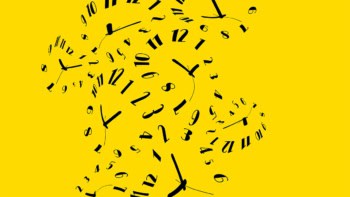Kate Gardner reviews Thought X: Fictions and Hypotheticals, edited by Rob Appleby and Ra Page

A soldier returning from war goes to visit the widow and young son of his fallen comrade Ted. During his stay with the family, the soldier takes on Ted’s name, chores and even his hobbies. Despite looking very different in appearance, he has effectively stepped into Ted’s life and his future is mapped out for him.
It doesn’t sound much like science, or even science fiction, but the short story “The tiniest atom” by Sarah Schofield is an exploration of “Laplace’s demon” – a thought experiment that explores the concept of free will in a universe that has to obey the laws of classical mechanics. As the accompanying essay by physicist Rob Appleby explains, Pierre-Simon Laplace theorized that if we know the forces acting on a body, and the precise location and momentum of all of its atoms, we can calculate its past and future. If everything in the universe obeys the same physical laws, then, with the right equations, we can determine the state of the universe – and everything and everyone in it – at any point in the past or the future. All of this suggests there is no free will.
This is just one of 14 pairs of short story and essay in Thought X: Fictions and Hypotheticals, which has at its root the concept that “thought experiments” in science and philosophy effectively tell stories as they build a scenario to prove some point – so why not get fiction authors, as well as scientists and philosophers, to explore them? After all, science and fiction share a capacity for taking the nub of an idea and stretching it far beyond immediate observations. This can lead to great stories and great breakthroughs.
The collection’s co-editors are Appleby, who works at the University of Manchester and the Cockcroft Institute, and Ra Page, who followed up his degree in physics and philosophy with a career in writing and editing short stories. The anthology – part of Comma Press’s ongoing Science-into-Fiction series – received funding from the Institute of Physics (which publishes Physics World) so perhaps it’s not surprising that the majority of the thought experiments here come from physics. From the grandfather paradox of time travel, to Maxwell’s demon, to Olber’s paradox, to Schrödinger’s cat, there is plenty to explore. The other thought experiments come from philosophy, and will perhaps be less familiar to Physics World readers, but no less fruitful.
As the name suggests, a thought experiment makes use of a hypothetical situation to prove or disprove a theory. Although such analyses have been dismissed in favour of practical experiment in modern times, they remain important where practical experiment isn’t (yet) possible – in new areas of physics and mathematics – or where practical experiment might be unethical, such as some strands of psychology. They also remain a very useful teaching tool. Indeed, some of them are simply analogies to explain a concept. Take the oldest example in this book: Galileo’s ship. Galileo knew that the Earth travelled around the Sun. Copernicus had done the maths; but people refused to believe it, because they couldn’t feel or see the Earth moving. So Galileo found a way to explain it that made sense to anyone who’d travelled on a ship.
The fiction in Thought X varies from purely metaphorical to more literal interpretations, but several stories try to do both. In “The tiniest atom”, the deceased Ted’s notebook is filled with jottings from public lectures and his own attempts to isolate the formula that will describe everything. In “Lightspeed” by Adam Marek a space pilot is damaging his marriage by taking longer and longer shuttle runs at near-lightspeed, increasing the physical and mental distance between himself and his wife. Physicist Tara Shears explains the effect of relativity on time and the resultant twin paradox – and why it’s not a paradox at all.
The genre, style, length and pace of the stories varies a lot for such a small collection. It’s unlikely one reader will love all of them, but it would also be a surprise if a reader didn’t find something to love here. The essays are uniformly clear and thorough, the only real variety being how much they interact with the story they follow. The best pairs of story and essay act to help explain each other. In “Tether” by Zoe Gilbert, Hark has built a house for Gertie. All he wants is to make her happy. But Gertie has discovered a shortcut to achieving pure happiness solo, so why would she choose anything else? Philosopher Jonathon Wolff explains that this is about the “experience machine” – a thought experiment by philosopher Robert Nozick that questions utilitarianism and authenticity. If all we value is achieving happiness, then we would all plug into the machine. But by plugging into the machine we cut ourselves off from the rest of the world, which does not give us pure happiness, but which we nevertheless value. Gilbert’s story perfectly illustrates this choice. And Wolff’s essay helps unpack a story filled with complex ideas and motives.
Thought X is a fascinating experiment and by choosing the right roster of writers, it achieves its aim.
- 2017 Comma Press 272pp £9.99pb



